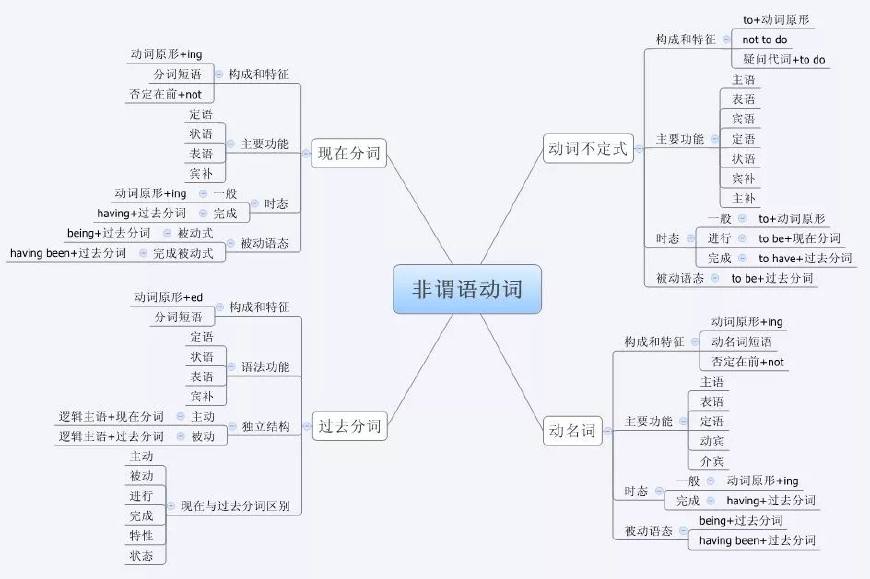一张图一个故事,搞明白英语里面的非谓语动词
2018-03-29 15:41:00
来源: 毙考题
0评论
非谓语动词,又叫非限定动词,指在句子中不是谓语的动词,主要包括不定式、动名词和分词(现在分词和过去分词),即动词的非谓语形式。
非谓语动词除了不能独立作谓语外,可以承担句子的其他成分。

非谓语动词的用法
1.be+-ed+介词结构常可把be去掉保留-ed+介词做状语。
Lily’s new dog is very aggressive, compared with her old one.
解析:
“Lily现在的狗狗与她以前的比很凶。”
“和……相比较”结构为be compared with,现在做句子的状语,所以只保留非谓语动词,把动词be去掉。

2.若两个句子之间如果没有连词连接,则需要用非谓语动词。
(1)He had been told many times, but the courier still did it.
(2)Having been told many times, the courier still did it.
解析:
“尽管被告知了多次,这个快递员还是这么做了。”
(1)中有连词but连接,故不需用非谓语形式。
(2)中后面是一个句子,而且没有连词,所以前面不是个句子,应该用非谓语动词。
3.非谓语动词作状语,其逻辑主语必须和句子主语保持一致,和句子主语构成主谓关系时用-ing形式,构成动宾关系时用-ed形式。
其逻辑主语和句子主语不一致时,要在非谓语动词前加逻辑主语,构成独立主格结构。
(1)Bitten twice, the courier refused to deliver Lily’s parcels unless she changed her dog.
解析:
“被狗狗咬了2次,这个快递员拒绝给Lily送快递除非她把狗狗换掉。”
本句考查非谓语动词作状语,其逻辑主和句子主语 the courier(快递员)一致,the courier应该是被咬,所以用bitten。
(2)Biting the courier twice, Lily’s dog didn’t feel sorry at all.
解析:
“咬了这个快递员2次,Lily的狗狗一点也不觉得抱歉。”
本句其逻辑主语应和句子主语Lily’s dog一致, Biting 和dog应该是主动关系。本句考查doing的否定形式not doing。

4.非谓语动词的否定原则是在非谓语动词前加not,有not to do, not doing, not having done, not to have done几种形式。
Not realizing that he was in great danger, the dog walked deeper into the forest.
解析:
“没有意识到危险,这条狗狗误入了森林深处。”
5.非谓语动词的完成时形式to have done或having done强调该动作发生在句子谓语动词之前。
Having failed to find the dog, Lily went home and called the police.
解析:
“没有找到狗狗,Lily就先回家了并报了警。”
没有找到狗狗应该发生在回家之前,所以用having done形式。

6.不定式做状语一般有两种:目的状语和表示出乎意料的结果状语(表示顺其自然的结果用-ing形式)。
另外,某些形容词(表喜、怒、哀、乐)做表语后跟不定式可以表示原因。
(1)To be a good courier, he decided to be friends with the dog.
解析:
“想成为一个合格的快递员,他决定和这条狗狗做朋友。”
此处表目的,所以用不定式。
(2)The courier hurried to Lily’s home, only to be told that the dog had lost.
解析:
“快递员匆匆赶到Lily家,却被告知狗狗已经丢了。”
表出乎意料的结果常常用only to do。
7.介词后跟-ing形式,可以在-ing前加逻辑主语。
The discovery of new evidence led to the dog being found.
解析:
“新的证据使这条狗狗被找到。”
led to中的to是介词,后面应该用-ing形式,the dog作-ing的逻辑主语。
8.不及物动词没有-ed形式的非谓语动词,及物动词在有宾语时用-ing形式,无宾语时用-ed形式。
Lost in the forest for a few days, the dog was finally saved by the courier.
解析:
“失踪了几天后,这条狗狗终于被快递员救出来了。”
lose为及物动词,并且后面没有宾语,所以用-ed形式。

9.非谓语动词作定语时,表示将来用-to do,表正在进行用-ing,表示已经完成用-ed。
The party to be held next week aims mainly to celebrate the dog’s back.
解析:
“下周,庆祝狗狗安全回家的party将被举行。”
根据本题中的时间状语next week,可知the party将要于下星期举行,表将来应该用to do。
10.-ing形式或to do可作主语或宾语,-ed形式则不可以。
Meeting twice a week, is an unwritten understanding between the courier and the dog.
解析:
“每周见面2次已经成为快递员与这只狗狗的默契了。”
本句中is为系动词,前面应该作主语,用-ing形式。
[责编:温仁]
评论
全部评论(0)
-
该文章暂时没有被评论过哦!


热门新闻
-
考研:招生越多压力越大的背后
0评论 2660天前
-
全国32.3万人报考北京研究生增一成
0评论 2660天前
-
2018年在职研究生复试 这些资料绝对不能忘带
0评论 2611天前
-
2019考研:听说复试中被刷掉的人都有这3个特点!
0评论 2611天前
-
14岁男孩入研究生复试:年龄不够参加高考只好考研
0评论 2589天前
大家都在看
-
考研:招生越多压力越大的背后
0评论 2660天前
-
全国32.3万人报考北京研究生增一成
0评论 2660天前
-
2018年在职研究生复试 这些资料绝对不能忘带
0评论 2611天前
-
2019考研:听说复试中被刷掉的人都有这3个特点!
0评论 2611天前
-
14岁男孩入研究生复试:年龄不够参加高考只好考研
0评论 2589天前

用户名